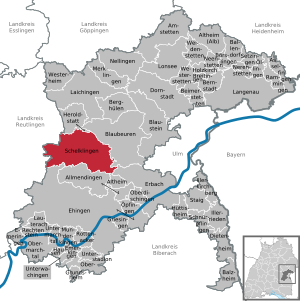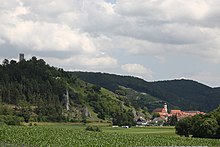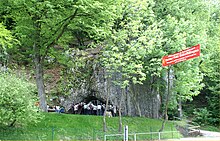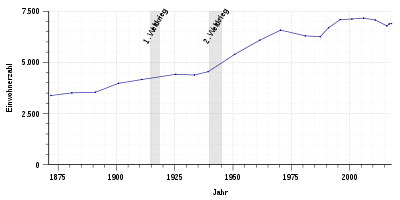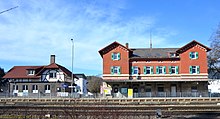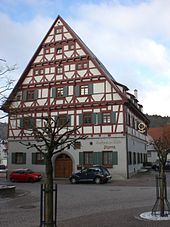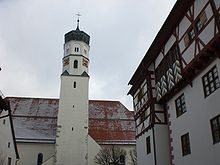Rogue blades
| coat of arms | Germany map | |
|---|---|---|

|
Coordinates: 48 ° 23 ' N , 9 ° 44' E |
|
| Basic data | ||
| State : | Baden-Württemberg | |
| Administrative region : | Tübingen | |
| County : | Alb-Danube district | |
| Height : | 540 m above sea level NHN | |
| Area : | 75.8 km 2 | |
| Residents: | 6883 (December 31, 2018) | |
| Population density : | 91 inhabitants per km 2 | |
| Postal code : | 89601 | |
| Primaries : | 07394, 07384 | |
| License plate : | UL | |
| Community key : | 08 4 25 108 | |
| LOCODE : | DE SCI | |
City administration address : |
Marktstrasse 15 89601 Schelklingen |
|
| Website : | ||
| Mayor : | Ulrich Ruckh | |
| Location of the town of Schelklingen in the Alb-Donau district | ||
Schelklingen is a town in the Alb-Donau district in Baden-Württemberg , about 20 kilometers west of Ulm . Schelklingen is part of the Swabian Alb biosphere area with a large part of its territory (82.2%) .
geography
Geographical location

The core town of Schelklingen is 547 m above sea level. NN in the Urdonautal , through which the Schmiech flows, at the foot of the Swabian Alb, about 20 kilometers west of Ulm . The districts of Hausen ob Urspring , Justingen and Ingstetten are located on the Alb plateau. In the Schmiechtal are the districts of Schmiechen , Hütten , Gundershofen , Sondernach and the residential areas Teuringshofen , Talsteusslingen and Springen.
On both sides of the valley and about 200 meters higher are undulating plateaus - in the southwest Ehinger Alb and Lutheran Mountains , in the northeast the Blaubeurer Alb and in the east (towards Ulm) the loosely populated Hochstrasse . The Schelklinger Ach rises to the west of the city near the Urspring Monastery in a bluish source pot (similar to the blue in the nearby Blaubeuren ) , which follows the Urdonautal to the north, where it joins the Blau at Blaubeuren .
Neighboring communities
The city borders in the north on Heroldstatt , in the east on the city of Blaubeuren , in the southeast on the city of Erbach (Danube) , in the south on Altheim and Allmendingen , in the west on Mehrstetten and the city of Münsingen (district of Reutlingen), and in the northwest on the Community-free area of the Münsingen manor district ( Reutlingen district ).
City structure
The city districts Schmiechen, Hausen ob Urspring, Justingen, Ingstetten, Hütten, Gundershofen and Sondernach . There are other individual farms, mills, smaller hamlets, castles and a former monastery that belong to the districts: Hof Muschenwang (zu Hausen ob Urspring), Hof Oberschelklingen (zu Schelklingen), hamlet Sotzenhausen (former cement factory, zu Schelklingen; is not to be confused with the hamlet of Sotzenhausen , which was incorporated into Pappelau , town of Blaubeuren in 1835 ), Mühlenweiler Springen (to Gundershofen), Riedmühle (to Sondernach), Weiler Talsteußlingen and Neusteusslingen Castle (to Hütten), Weiler Teuringshofen (to Hütten) and Urspring (to Schelklingen).
Flowing waters
- The Urspring rises in Urspring and flows into the Ach after approx. 500 m
- The Ach rises between Urspring and Schelklingen and flows into the Blau in Blaubeuren
- The Schmiech rises at Springen and flows into the Danube in Ehingen
- The Sondernach rises in the Sondernach valley and flows into the Schmiech at the Riedmühle
history
Middle Ages with the nobles von Schelklingen and the Counts von Berg
The original owners of the village and the Schelklingen castle were free lords of Schelklingen, probably related to the lords of Steusslingen, Justingen, etc.
In 1127 three brothers, called von Schelklingen, donated goods to the Urspring Monastery. Through purchase, marriage or inheritance, the Schelklingen rule came to the Counts of Berg around 1200 , from whom the later Counts of Berg-Schelklingen emerged . Margrave Heinrich I von Burgau and his wife Adelheid, probably the daughter of the last noble von Schelklingen, fathered Ulrich as the firstborn, who had to share the inheritance with his brother after his father's death in 1242. Ulrich received the rule of the House of Berg in the west of the Iller and the small rule of Holzheim near Neu-Ulm, between Iller and Roth and called himself Count von Berg (-Schelklingen) in future. His brother was Heinrich II. Von Burgau and ruled as margrave over the area east of the Roth and with Burgau, so that he added a lily to the coat of arms and seal of the counts of Berg because of the demarcated margraviate of Burgau.
Schelklingen was first named city ( civitas , city law ) in 1234 . The last Count of Berg-Schelklingen sold the rule to the House of Austria in 1343 and received it back as a fief. When the last count of Berg-Schelklingen died in 1346, the Schelklingen rule fell to Austria.
Schelklingen was later administratively assigned to Upper Austria and remained Austrian until 1806.
The financial difficulties of the Dukes of Austria and the prestige on the part of the nobility associated with owning their own rule led to the frequent pledging and conferring of the Schelklingen rule (together with Berg and Ehingen).
Pawnbrokers
- 1438–1458 Hans the Rich von Stadion († 1458 childless)
- 1459–1503 his nephew Burkhard von Stadion († 1493), son of Ludwig von Stadion († 1449)
- 1507–1530 Ludwig von Freyberg zu Öpfingen
- 1530–1568 Konrad von Boyneburg
In 1568 the city of Ehingen was able to buy itself out of a new pledge and at the same time acquire the lien over Schelklingen. From 1568 to 1680 the town and the rule were administered by Austrian governors .
Feudal rule of the Schenk von Castell
In 1680, Imperial Count and Bishop of Eichstätt Marquard Schenk von Castell remembered his services to the emperor. As a thank you, the lords of Berg and Schelklingen were initially pledged and left in 1732 as a man fief from the front of Austria . The feudal rule of the Schenk von Castell lasted until the middle of the 19th century. Franz Ludwig Schenk von Castell played an important role for Schelklingen at the end of the Ancien Régime . As a result of the Peace of Pressburg in 1805, Schelklingen fell to the Electorate of Württemberg , as a thank you for the Württemberg arms aid that Napoleon had provided. The transition of state rule from Front Austria to Württemberg in the course of mediatization also gradually ended the aristocratic rule over Schelklingen. The Counts Schenk von Castell gradually sold their property in Schelklingen.
Württemberg time
Schelklingen came in 1808 with the implementation of the new administrative divisions in the Kingdom of Württemberg to Oberamt Blaubeuren .
In 1879/80 years pastor Wilhelm Hummel in Schelklingen founded a Catholic rescue facility for boys , the St. Konradi House (Konradihaus), in the building of the bankrupt malt factory and the associated Gasthaus zum Hecht by Joseph Baumeister .
In the 19th century Schelklingen developed from a town of craftsmen and farmers to an industrial town. The abolition of the Urspring Monastery in 1806 made the complex free for other uses. In 1832, the state of Württemberg sold the former monastery to the factory owner Georg Reichenbach , with the condition that a cotton factory be set up there. The later Mechanische Weberei Urspring ( MWU ) was relocated to a new building on Ehinger Strasse in Schelklingen in 1906/07. Most of the factory buildings in Urspring were demolished. The MWU went bankrupt in 1953 and was closed.
A second branch of industry that emerged in the 1830s was matchmaking. The basis was the invention of the phosphorus match. Three factories developed, which also employed many women and children at home. Most of these factories closed in the early 20th century.
In 1912, after the Dreikönigsmühle on the Achtopf had been converted into the municipal electricity and waterworks, a new grain mill was built in Urspring, which is now used as a school building. From 1907 to 1930, the Urspring buildings were essentially empty apart from one inn. It was not until 1930 that the former monastery complex found a new use with the establishment of the Urspring School, a Protestant rural education home and grammar school.
In the late 19th century, after Portland cement had been invented, the new branch of the cement industry developed in the Blau, Ach and Schmiechtal valleys. In 1889 the first Barbey'sche, later Hammerstein'sche cement factory was built in Schelklingen, and in 1902 the large complex of the Stuttgart real estate and construction business , which shut down the Hammerstein'sche cement works and set up cement workers' apartments there. The new factory attracted a large number of foreign workers, including many Italian workers, some of whom became resident. The cement plant was later bought up by Portland-Cement-Fabrik AG Heidelberg and Mannheim AG , now HeidelbergCement .
Nazi era
During the district reform during the Nazi era in Württemberg , Schelklingen came to the district of Ehingen in 1938 .
In 1941, the St. Konradi House was confiscated by government agencies and a resettlement camp ( SS camp) was set up there until 1945 . It was intended to be used for the forcible re-education of internees from Alsace , who were deemed “racially pure”, and to test the “ability to Germanize” other forced deportees.
post war period
After the end of the Second World War, Schelklingen was part of the French occupation zone and was thus assigned to the newly founded state of Württemberg-Hohenzollern in 1947 , which became part of the state of Baden-Württemberg in 1952.
Spatial development of the urban area
In the course of the municipal reform in Baden-Württemberg , the following municipalities were incorporated into Schelklingen or merged with Schelklingen:
- March 1, 1972: Hausen ob Urspring and Justingen
- April 1, 1972: Ingstetten and Hütten
- July 1, 1974: Schmiechen (union with Schelklingen to form the new town of Schelklingen)
- January 1, 1975: Gundershofen and Sondernach
Before the district reform, Schelklingen, Hausen ob Urspring and Schmiechen belonged to the district of Ehingen , the other municipalities to the district of Münsingen . During the district reform of Baden-Württemberg in 1973 , all places in Schelklingen became part of the Alb-Danube district .
 Gundershofen |
 Hausen ob Urspring |
 Huts |
 Ingstetten |
 Justingen |
 Smack |
 But after |
As part of the remunicipalisation of the community-free manor district of Münsingen (Reutlingen district), the uninhabited former ammunition depot of Ingstetten, 56.3 hectares in size, was added to the town of Schelklingen on January 1, 2011.
Population development
These are population numbers according to the respective territorial status. The numbers are census results (¹) or official updates from the Baden-Württemberg State Statistical Office (only main residences ).
|
|
Religions
Overview
Schelklingen was predominantly Catholic until 1806 due to the fact that it belonged to the former Schelklingen rule (town of Schelklingen, Hausen ob Urspring and Schmiechen) and the monastery rule from Urspring to Upper Austria . The places of the former imperial rule of Justingen (Justingen, Ingstetten, Gundershofen and Hütten) were reformed from the middle of the 16th century until after the end of the Thirty Years War under the Barons of Freiberg according to the doctrine of Schwenckfeld , but were after the repurchase of the rule by the Prince-Bishop of Augsburg Johann Christoph von Freiberg (1665–1690) recatholicized. But as part of the rule Neusteusslingen was Catholic under the barons of Freiberg zu Neusteusslingen; after the reign of the Duchy of Württemberg fell back in the late 16th century, the Reformation was introduced there.
Today there is a Roman Catholic , Protestant and New Apostolic church in Schelklingen .
There is also a Muslim population. Most Muslims are followers of Sunni Islam . Since the early 1960s, Islamic fellow citizens have settled here through immigration , mainly from Turkey . For some years now, there has also been a small place of prayer for the Muslim population on the outskirts of Schelklingen.
Catholic parish priest at the Sacred Heart of Jesus
(only from 1807)
- 1807 to 1819 Leo Wanker von Spaichingen (* Spaichingen 1743, † 1823)
- 1819 to 1828 Dominikus Modino von Rottweil (* Rottweil 1779, † 1828)
- 1829 to 1844 Fidel Braig von Ehingen a. D. (* Ehingen a. D. 1784, † Schelklingen February 22, 1844)
- September 25, 1844 to September 1, 1851 Philipp Frank (* Löffelstelzen March 26, 1803; † June 9, 1866 in Ödheim), December 1, 1849 to 1851 member of the Württemberg state parliament
- 1853 to January 18, 1870 Erhard Meyer von Oberndorf aN (* Oberndorf aN1807, † 1876). Was transferred to the Catholic parish of Fulgenstadt on January 18, 1870.
- 1870 to November 28, 1883 Wilhelm Hummel von Donzdorf (* Donzdorf 1828/1829, † Schelklingen November 28, 1883), school inspector, founder of the St. Konradi House , had the wall paintings in the St. Afra Chapel uncovered and restored
- November 28, 1883 to August 6, 1884 NN Klozbücher, parish administrator
- August 6, 1884 to 1900 Otto Türk (* Wolfegg June 24, 1842, † Immenstadt im Allgäu January 20, 1909), previously in Winterstettenstadt, Knight of the Holy Sepulcher, Chairman of the St. Konradi House, had the Lourdes Grotto built in Schelklingen
- 1901 to 1916 Joseph Schumacher, school inspector, director of the St. Konradihaus, the St. Antoniushaus in Pfauhausen a. of the voluntary priestly sick support association, member of the advisory board of the central management of the charitable association in Stuttgart, holder of the Karl-Olga-Medal (* Kümmerazhofen (Reute-Waldsee) February 25, 1861, † Schelklingen November 26, 1918)
- 1916 to 1923 Karl Eugen Stolz (born November 11, 1874 in Rottenburg am Neckar; † May 4, 1936 in Tübingen), since 1923 associate professor for pastoral theology at the University of Tübingen
- October 28, 1923 to July 14, 1942 (sick since September 19, 1939) Franz Sales Buck (* Großengstingen 1879, † Schelklingen July 10/11, 1944, buried in the Schelklingen cemetery)
- July 15, 1934 Thomas Kaufmann, vicar
- September 1939 to May 17, 1943 Karl Kunz, Father (and Pastor Maier (83 years old))
- May 17, 1943 to April 28, 1944 Dr. Eugen Fischer, repetiteur
- April 28, 1944 to September 24, 1944 Albert Tanz, Father
- September 24, 1944 to September 13, 1949 Dr. Ernst Hofmann from Ulm (* 1904)
- September 13, 1949 to April 30, 1977 Thomas Kaufmann, parish priest, clergyman
- June 7, 1977 until after 1986 Lothar Helmle, parish priest
- September 1991 to May 6, 2012 Claus Stoll, parish priest (* Stuttgart 1960)
- since May 26, 2012 Anthony Kavungal CMI, Father and Parish Vicar (* India, Kerala 1960)
politics
Municipal council
The municipal council consists of the elected voluntary councilors and the mayor as chairman. The mayor is entitled to vote in the municipal council. In Schelklingen, the municipal council is elected using the spurious selection process . The number of local councils can change due to overhang mandates . After the last election, the municipal council in Schelklingen has 25 members (previously: 24). The local elections on May 26, 2019 led to the following official final result (with comparative figures from the two previous elections):
| Parties and constituencies | % 2019 |
Seats 2019 |
% 2014 |
Seats 2014 |
% 2009 |
Seats 2009 |
||
|---|---|---|---|---|---|---|---|---|
| CDU | Christian Democratic Union of Germany | 42.8 | 11 | 46.2 | 11 | 31.6 | 9 | |
| SPD | Social Democratic Party of Germany | 24.9 | 6th | 29.5 | 7th | 19.0 | 5 | |
| Green | Alliance 90 / The Greens | 4.4 | 1 | - | - | - | - | |
| FW | Free electoral association | 27.8 | 7th | 24.4 | 6th | 18.0 | 5 | |
| PER | Pro Schelblades | - | - | - | - | 31.5 | 8th | |
| total | 100 | 25th | 100 | 24 | 100 | 27 | ||
| voter turnout | 62.4% | 56.31% | 60.9% | |||||
mayor
During the Austrian period, the city administration was in the hands of the ruling mayor and his predecessor, the mayor . They were supported by the internal and external council , each with four members (councilors, deputies). The city offices (such as city calculators, church administrators, hospital administrators, etc.) were divided among the councilors. The term of office seems to have been a year; but re-elections were possible, as the mayors' long terms of office show. After 1806, Württemberg introduced the office of mayor elected for life and later changed to the title Stadtschultheiß . In 1930, the official title of mayor was introduced in Württemberg , which is still used today. The mayor is currently elected for a term of eight years.
List of Schelklingen mayors (incomplete before 1800)
|
|
coat of arms
Blazon : Divided by red and silver (white) five times obliquely to the left. The Counts of Berg-Schelklingen carried such a coat of arms. The city colors are white (silver) and red.
Economy and Infrastructure
traffic
Schelklingen is a branch station . Here the Reutlingen – Schelklingen railway separates from the Ulm – Sigmaringen railway . While only individual trains run on the former, there is a good range of regional express and regional trains on the latter . This means that at least two trains per hour run to Ulm. After Sigmaringen an hour prevails clock , according Donaueschingen is with regional express trains, a two-hour intervals. Regional trains run every hour that go through Ulm to Memmingen . In addition to the Schelklingen train station, the city has one station each in the Schmiechen district on the Reutlinger and Sigmaringer routes, as well as two stops in Hütten and Sondernach an der Albbahn. Schelklingen belongs to the Danube-Iller local transport network .
The city is connected to the national road network via the federal highway 492 ( Blaubeuren - Ehingen ) and can be reached via the Merklingen and Ulm-West exits of the A 8 .

fire Department
The Schelklingen volunteer fire brigade was founded in 1871.
Companies
The Schelklinger trade association was founded in 1914.
In the city there are larger plants of HeidelbergCement AG and Cooper Standard Automotive .
education
In Schelklingen there is the Heinrich-Kaim-Schule, a primary and secondary school with a Werkrealschule as well as four further primary schools in the suburbs that are run by the city.
In addition, Schelklingen has a high school with a boarding school , which is run by Protestants, with the Urspring School . In addition to the Abitur, you can also complete an apprenticeship.
The St. Konradihaus is a youth welfare facility with boarding school , in which young people from the age of 12 can receive school and professional training.
There are also four Roman Catholic , two municipal and one Protestant kindergartens throughout the city.
Culture and sights
library
The city library is housed in the old town hall. It has an inventory of around 15,000 media.
theatre
There is a theater association that performs popular plays. There is no longer a theater.
Museums
The city museum Schelklingen in the old hospital is located together with the city archive in the representative half-timbered building and former hospital of the Holy Spirit next to the church, whereby it presents the natural history and history of the city from Schelklingen and its districts.
music
The oldest music associations and groups include the Liederkranz Schelklingen (founded in 1826), the Catholic church choir (founded in 1894), the music association Stadtkapelle Schelklingen (founded in 1923) and the music association Schmiechen (founded 1927).
societies
The gymnastics and sports club Schelklingen (TSV) was founded in 1891. The local group Schelklingen of the Swabian Alb Association has existed since around 1890.
Buildings
Castles and Palaces
- Nearby are the ruins of the castle on the city Hohenschelklingen , the castles Muschenwang and Studach , the castle Justingen , the castle and the castle Neusteußlingen ; the tower castle of Schmiechen can only be traced back to archival and archaeological records.
Church buildings
- Origining monastery with the St. Ulrich monastery church , founded in 1127, parts of the building dating from around 1500 (two guest buildings and the east wing of the cloister as well as the narthex and lower part of the bell tower of the monastery church), otherwise mostly 17th century
- City parish church Herz-Jesu , new building from 1934, whereby the late Gothic former sacristy, today a side chapel, and the church tower, in its lower floors Romanesque with humpback blocks, have been preserved; the upper part of the church tower and the onion dome were built in 1905 by Joseph Cades (Maximilian-Kottmann-Platz)
- St. Afra Chapel in the cemetery: built in the 14th century
- Herz-Jesu-Kapelle on the Herz-Jesu- / Litzelberg: built 1708–1709
- Maria-Hilf-Chapel : donated in 1882 by the language teacher Ida Götz and extended by a transept by the same donor in 1904 (Münsingerstraße 12)
- Lourdes grotto : laid out in 1885 by the parish priest Türk (Münsingerstraße am Schloßberg)
Parish and chaplain houses
- Old rectory , splendid half-timbered house from around 1600 (Maximilian-Kottmann-Platz 6)
- New rectory , formerly Westernach'sches Kaplaneihaus of the Urspring Monastery , later city chancellery (Kanzleigasse 1)
- Wernau'sches Kaplaneihaus , residence of the Wernau chaplain ; Baroque building in French style, built in 1756 (Kanzleigasse 3)
- Roth'sches Kaplaneihaus , residence of the chaplain of the Rodt von Bußmannshausen family ; Baroque building from approx. 1750 with Madonna niche and formerly hipped roof, today heavily changed (Stadtschreiberereistraße 1)
Nobility seats
- Spital zum Heiligen Geist , former residence of the Lords of Wernau (built in the 14th century) with the Spitalbrunnen (Spitalgasse 6)
- Bemelberger Schlössle , residence of Konrad von Boyneburg (built around 1550) (Bemmelbergergasse 1/3)
- Gasthaus zum Rößle , former home of Hanß Reuss von Reußenstein (built in the second half of the 16th century) (Färbergasse 2)
- Stauffenberg'sches Schloss , residence of the Schenk von Stauffenberg (built around 1600) (Schloßgasse 9/11/13/15/17)
- Rennhof , residence of the Renner von Allmendingen family (built in the 2nd half of the 16th century) (Schloßgasse 5)
Urban buildings

- The old town hall (built around 1450) (Marktstraße 8)
- The city wall : original parts in the outer walls of houses; received up to the full amount at the Bemelberger Schlössle ; a piece reconstructed at the Hospital of the Holy Spirit
- The rear fountain : public city fountain
Town houses
- Town house with beautifully restored half-timbering (with unresolved inscription on the south-east post beam "RCIR 1544"). (Maximilian-Kottmann-Platz 9 and 11)
- Farmhouse and barn at the former rear gate , leaning against the city wall with restored half-timbering (dated 1705) (Stadtschreibereistraße 5)
- New house , baroque house of Franz Xaver Schalch, court master of the Urspring Monastery (built 1717) (Bemmelbergergasse 2)
- Gasthaus zur Sonne , formerly Gasthaus zur Güldenen Sonne , oldest tavern and hostel (heavily rebuilt or newly built in 1724) (Marktstraße 9)
- Former bathhouse (Färbergasse 20, 22 and Schloßgasse 1)
- Community house on the site of the first Schelklingen hospital (donated in 1550, located at the Vorderen Tor until 1698, then moved to the Wernau castles ), built in 1794–1795. In the new building, timber from the previous building from the years 1345–1346 was reused in the area of the inner framework and roof. The building from 1345–1346, which was canceled in 1794–1795, must have been the building of the first hospital. The new building from 1794–1795 housed the Lamm restaurant in the 1820s and 1830s . The building had to give way to the new Ortisei community center around 2010 .
Sports
- Outdoor swimming pool
- Skate facility
- Football pitch and sports facilities in the Längental
Regular events
- Swabian-Alemannic carnival groups move
- Nicholas market on the first Saturday in December
- Farmer's and weekly market on Wednesday mornings
Culinary specialties
Typical Swabian dishes (such as Maultaschen, Sour Kutteln, Sauerbraten etc.) are offered by various Schelklingen restaurants.
Natural monuments
- the Hohle Fels , a limestone pillar with a large cave that was inhabited in the Stone Age (visit possible)
- the Schmiechener See or Schmiecher See ( d'r Sai ), today a nature reserve
- the blue spring pot (round karst spring) of the Urspring west of the city.
Personalities
Honorary citizen
The city of Schelklingen has granted the following people honorary citizenship:
- June 23, 1879: Robert Friedrich Rall (1849–1935), manufacturer of cotton fabrics; Reason: "because he gave the workers much better, gentler and fairer treatment than is generally the case"
- March 9, 1923: Heinrich Günter (1870–1951), historian
- November 22, 1946: Max Kottmann (1867–1948), prelate and vicar general
- April 11, 1956: Anton Fischer (1876–1956), city scholar and mayor
- 2000: Rudolf Stützle, mayor
- Year ?: Erich Karl (1924–2009), managing director and local politician
- April 4, 2014: Reiner Blumentritt (1943–2019), chairman of the Schelklingen Museum Society and local politician
sons and daughters of the town
The following overview contains important personalities born in Schelklingen, listed according to the year of birth. For the naming it is irrelevant whether the persons later had their sphere of activity in Schelklingen or not.
- Salome von Berg-Schelklingen (* around 1099 in the Donaukreis, Württemberg; † July 27, 1144), mother of famous children
- Christoph von Stadion (March 1478 - April 15, 1543 in Nuremberg), Bishop of Augsburg 1517–1543
- Johann Michael Wolcker (baptized in Schelklingen May 12, 1702; † October 16, 1784 in Schelklingen), painter
- Matthias Wolcker (born in Schelklingen, baptized February 22, 1704, † October 10, 1742 in Dillingen an der Donau), painter
- Gabriel Wolcker (baptized June 8, 1715)
- Maria Sybilla Josepha Zais b. Schalch (born May 3, 1770; † June 13, 1844 in Wiesbaden), hotelier
- Johannes Bumüller (born December 29, 1811, † September 13, 1890 in Ravensburg), grammar school professor, editor and Catholic writer
- Ludwig Lutz (born August 27, 1820; † 1889 in Ellwangen / Jagst), master bottle maker, manufacturer of tin toys in Ellwangen / Jagst
- Adolf Kaim (born June 15, 1825 - † August 4, 1887 in Biberach an der Riss), teacher and musician
- Franz Sales Günter (born November 9, 1830, † September 1, 1901 in Oberndorf am Neckar), administrative actuary and town councilor
- Sebastian Luz (born March 7, 1836; † May 2, 1898 in Freiburg / Breisgau), painter of religious subjects, history, portrait and landscape painter
- Franz Josef Werner (born February 2, 1847, † June 5, 1908) was editor and publisher of the Lauchert newspaper and director of the Ulmer Zeitung
- Josef Mohn (born October 20, 1866 - † December 25, 1931), master bottle maker and inventor
- Max Kottmann (born June 16, 1867 in Sotzenhausen near Schelklingen, † March 22, 1948 in Rottenburg am Neckar), vicar general of the Rottenburg diocese, honorary citizen
- Heinrich Günter (born February 15, 1870; † May 13, 1951 in Munich), historian, honorary citizen
- Emil Kaim (born January 23, 1871 - † May 9, 1949 in Untermarchtal), priest and member of the state parliament
- Heribert Jone (born January 30, 1885 - † December 25, 1967 in Stühlingen / Baden), Catholic priest, canon lawyer and moral theologian
- Hans Beckers (born December 27, 1902, † January 22, 1984 in Donaustauf), architect, master church builder
Other personalities
Well-known personalities are listed here who spent part of their life in Schelklingen or who died in Schelklingen.
- Johann Georg Wolcker the Elder (* Burgau ?, ⚭ 1700 or earlier; † Augsburg?), Baroque painter in Schelklingen
- Johann Georg Wolcker the Younger (* 1700, † October 27, 1766 in Augsburg) grew up in Schelklingen from 1702 at the latest
- Friedrich List (* no later than August 6, 1789 in Reutlingen; † November 30, 1846 in Kufstein), 1809–1810 Württemberg tax renovator in Schelklingen, author of the Schelklingen tax book from 1810 (2 volumes)
- Johann Georg Friedrich Reichenbach (born June 22, 1791 in Montbéliard as the son of chamber surgeon Wilhelm Heinrich Reichenbach ; † 1873 in Stuttgart), founder and owner of the cotton weaving mill Urspring from 1832–1852
- Heinrich Kaim (born October 2, 1792 in Steinbach near Esslingen / Neckar, † March 31, 1874 in Schelklingen), model teacher in Schelklingen, founder of the Schelklinger Liederkranz
- Christian August Blezinger (born January 25, 1811 in Ernsbach; † April 8, 1894 in Stuttgart), merchant, ironworks owner in Ernsbach and later cotton manufacturer in Urspring
- Louis Adam Gans (born May 24, 1819 in Kassel), businessman, textile manufacturer in St. Gallen and later cotton manufacturer in Urspring
- Jakob Friedrich Sprandel (born January 24, 1828 in Ulm / Donau; † January 2, 1895 in Schelklingen), surgeon and obstetrician
- Robert Friedrich Rall (born June 3, 1849 in Eningen unter Achalm; † March 2, 1935 in Ulm / Danube), owner and manager of the mechanical weaving mill Urspring (MWU) from 1870–1930
- Otto Merz (born June 12, 1889 in Esslingen am Neckar, † May 18, 1933 in Berlin), chauffeur, racing driver, test driver and mechanic
- Joseph Klarl (born October 1, 1909 in Straubing; † January 16, 1987 in Schelklingen), painter and artist, lived in Schelklingen since 1945
- Franz Beyer (born February 26, 1922 in Weingarten as the son of Otto Paul Beyer , music director in Weingarten (born September 12, 1885; † November 22, 1973 in Weingarten) and Anna Günter (born July 16, 1895 in Schelklingen; † 7 January 1992 in Weingarten)), violist at the University of Music and Theater in Munich; spent his youth in Schelklingen with his relatives
- Erich Karl (* 1924 in Ulm; † 2009 in Schelklingen), managing director and local politician
- Marie-Louise Roth-Zimmermann (born August 1, 1926 in Haguenau, Alsace; † May 25, 2014), literary scholar
literature
- Immo Eberl and Jörg Martin (2000): Documents from Blaubeuren and Schelklingen: Regesta from the city archives of Blaubeuren and Schelklingen and the Schelklingen parish archive. Ulm: Süddeutsche Verlagsgesellschaft (Alb and Danube: Art and Culture, 23). ISBN 3-9806664-2-5 .
- Immo Eberl, with the collaboration of Irmgard Simon and Franz Rothenbacher (edit.) (2012): The cases of family and civil status in the parishes of the town of Schelklingen and Ursprunging monastery (1602–1621, 1657–) 1692–1875 . 2nd edition Mannheim: Franz Rothenbacher.
- Heinrich Günter (1939): History of the city of Schelklingen up to 1806. Stuttgart and Berlin: W. Kohlhammer.
- Jörg Martin and City Archives Schelklingen (1999): View of Schelklingen: Photographs from 120 years of city history. Schelklingen: City Archives.
- Marie-Louise Roth-Zimmermann: I think of Schelklingen ... memories of an Alsatian woman from the time in the SS resettlement camp (1942–1945) . Röhrig Universitätsverlag, St. Ingbert 2001, 2nd edition, ISBN 978-3-86110-275-5 .
- Franz Rothenbacher (arr.) (1995): House book of the city of Schelklingen: Volume 2: House tables. Mannheim: Rothenbacher; Schelklingen: City of Schelklingen, City Archives. (2nd edition 2015 with name, place and subject index).
- Franz Rothenbacher (2006): Schelklingen: A guide through the city, Urspring Monastery, castles and sub-communities . Mannheim: self-published ( full text (PDF; 291 kB) )
- City of Schelklingen (Ed.) (1984): Schelklingen: History and life of a city. Published by the city of Schelklingen on the 750th anniversary of the city from 1234–1984 . Ulm: South German publishing company. ISBN 3-88294-062-X .
Web links
- "Schelklingen from the south", drawn by Ludwig Kolb in 1829. In the center of the picture the last tower of the city fortifications, the "Citizen Tower" (= prison), to the left of the linden tree the "Front Gate". The city wall is still largely preserved. In the background the ruins of Schelklingen Castle. [1]
- Schelklingen at LEO-BW
- City's website
Individual evidence
- ↑ State Statistical Office Baden-Württemberg - Population by nationality and gender on December 31, 2018 (CSV file) ( help on this ).
- ↑ Silvester Lechner : Review of "Roman Sobkowiak: Eindeutschungsbaren" in Gedenkstättenrundbrief 147 pp. 14-20 of the project Topography of Terror
- ^ Federal Statistical Office (ed.): Historical municipality directory for the Federal Republic of Germany. Name, border and key number changes in municipalities, counties and administrative districts from May 27, 1970 to December 31, 1982 . W. Kohlhammer, Stuttgart / Mainz 1983, ISBN 3-17-003263-1 , p. 527 and 543 .
- ↑ Population development in Baden-Württemberg from 1871 to 2012 ( page no longer available , search in web archives ) Info: The link was automatically marked as defective. Please check the link according to the instructions and then remove this notice.
- ^ The pastors before 1806 can be found in Stephan Krießmann (1950), Series Parochorum: order of the cath. Pastors in the parishes of the Diocese of Rottenburg (Württ.) Are compiled according to the deaneries . Altshausen, Württemberg Self-published by the author, chapter "Deanery Ehingen", "Parish Schelklingen" and Heinrich Günter (1939), history of the town of Schelklingen up to 1806 . Berlin u. Heidelberg: W. Kohlhammer, pp. 217-219; these two publications are also the main source of the pastors list.
- ↑ Baden-Württemberg State Statistical Office: Results of the 2019 municipal council elections - City of Schelklingen
- ↑ For him see the anecdote in the Zimmerische Chronik: Zimmerische Chronik, Volume 3, p. 352.
- ↑ Super User: Schelklingen City Museum. Retrieved on July 2, 2018 (German).
- ↑ See the building documentation in the building research / restoration database
- ^ Illustration of the city wall in 1780 in Franz Rothenbacher, The projected conversion of the Schelklingen hospital into a penitentiary 1780–1781 . Mannheim: Self-published, 2007. ( Full text (PDF; 286 kB) )
- ↑ See the building documentation in the building research / restoration database
- ↑ See the building documentation in the building research / restoration database
- ^ Wilhelm Lederer, Schelkling personalities and honorary citizens. In: Stadt Schelklingen (ed.), Schelklingen: History and life of a city. Ulm: Süddt. Verlagsges., 1984, p. 433; Klaus Brügelmann, Urspring as a factory. In: Urspring News 1987. Schelklingen. Original school foundation, pp. 23-25
- ↑ Manfred Hörner: STADION, Christoph von. In: Biographisch-Bibliographisches Kirchenlexikon (BBKL). Volume 10, Bautz, Herzberg 1995, ISBN 3-88309-062-X , Sp. 1087-1090.
- ^ Steichele: Christoph von Stadion . In: Allgemeine Deutsche Biographie (ADB). Volume 4, Duncker & Humblot, Leipzig 1876, pp. 224-227.
- ↑ Kathrin Brüggenthies: GÜNTER, Heinrich. In: Biographisch-Bibliographisches Kirchenlexikon (BBKL). Volume 30, Bautz, Nordhausen 2009, ISBN 978-3-88309-478-6 , Sp. 531-536.
- ↑ Volker Schäfer, New Finds on Friedrich List. Episode VI: Schelklingen 1809–1810: Friedrich List as a Württemberg tax innovator. In: Reutlinger Geschichtsblätter Jg. 1996, NF No. 35, 1996, pp. 183-220

